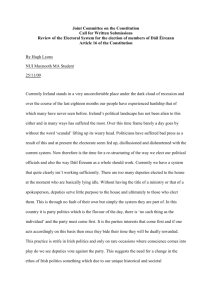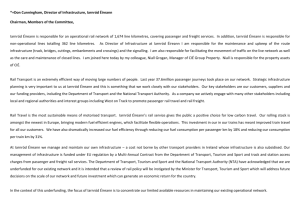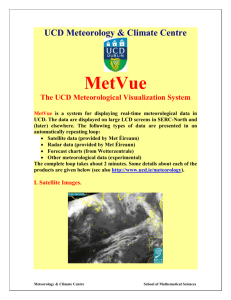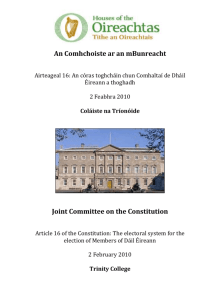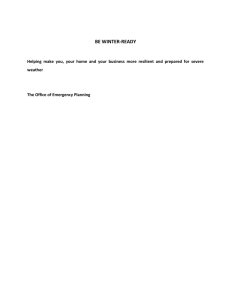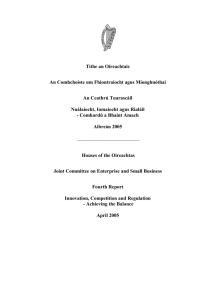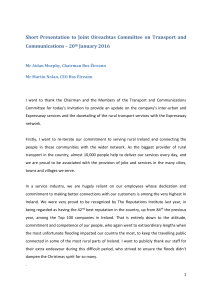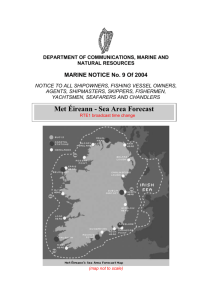Hitting the Target
advertisement
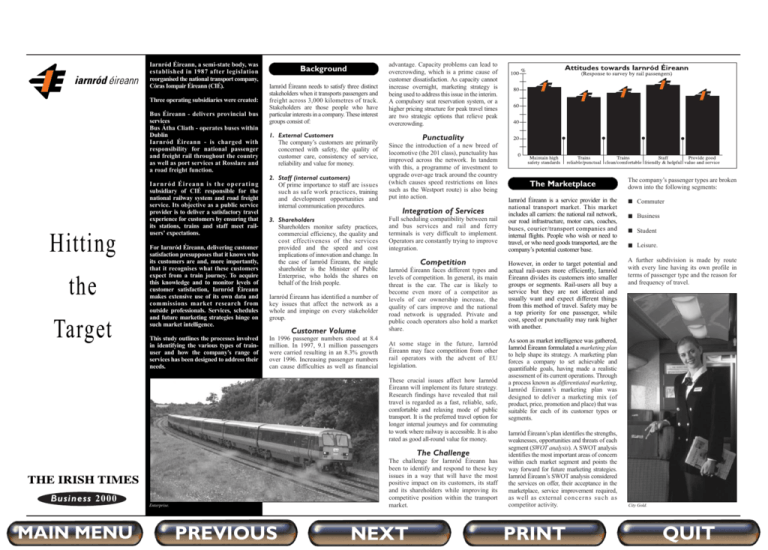
Iarnród Éireann, a semi-state body, was established in 1987 after legislation reorganised the national transport company, Córas Iompair Éireann (CIÉ). Three operating subsidiaries were created: Bus Éireann - delivers provincial bus services Bus Átha Cliath - operates buses within Dublin Iarnród Éireann - is charged with responsibility for national passenger and freight rail throughout the country as well as port services at Rosslare and a road freight function. Hitting the Target Iarn ród Éirean n is t h e operating subsidiary of CIÉ responsible for the national railway system and road freight service. Its objective as a public service provider is to deliver a satisfactory travel experience for customers by ensuring that its stations, trains and staff meet railusers’ expectations. For Iarnród Éireann, delivering customer satisfaction presupposes that it knows who its customers are and, more importantly, that it recognises what these customers expect from a train journey. To acquire this knowledge and to monitor levels of customer satisfaction, Iarnród Éireann makes extensive use of its own data and commissions market research from outside professionals. Services, schedules and future marketing strategies hinge on such market intelligence. This study outlines the processes involved in identifying the various types of trainuser and how the company’s range of services has been designed to address their needs. Background Iarnród Éireann needs to satisfy three distinct stakeholders when it transports passengers and freight across 3,000 kilometres of track. Stakeholders are those people who have particular interests in a company. These interest groups consist of: 1. External Customers The company’s customers are primarily concerned with safety, the quality of customer care, consistency of service, reliability and value for money. 2. Staff (internal customers) Of prime importance to staff are issues such as safe work practices, training and development opportunities and internal communication procedures. 3. Shareholders Shareholders monitor safety practices, commercial efficiency, the quality and cost effectiveness of the services provided and the speed and cost implications of innovation and change. In the case of Iarnród Éireann, the single shareholder is the Minister of Public Enterprise, who holds the shares on behalf of the Irish people. Iarnród Éireann has identified a number of key issues that affect the network as a whole and impinge on every stakeholder group. Customer Volume In 1996 passenger numbers stood at 8.4 million. In 1997, 9.1 million passengers were carried resulting in an 8.3% growth over 1996. Increasing passenger numbers can cause difficulties as well as financial advantage. Capacity problems can lead to overcrowding, which is a prime cause of customer dissatisfaction. As capacity cannot increase overnight, marketing strategy is being used to address this issue in the interim. A compulsory seat reservation system, or a higher pricing structure for peak travel times are two strategic options that relieve peak overcrowding. Punctuality Since the introduction of a new breed of locomotive (the 201 class), punctuality has improved across the network. In tandem with this, a programme of investment to upgrade over-age track around the country (which causes speed restrictions on lines such as the Westport route) is also being put into action. Integration of Services Full scheduling compatibility between rail and bus services and rail and ferry terminals is very difficult to implement. Operators are constantly trying to improve integration. Competition Iarnród Éireann faces different types and levels of competition. In general, its main threat is the car. The car is likely to become even more of a competitor as levels of car ownership increase, the quality of cars improve and the national road network is upgraded. Private and public coach operators also hold a market share. At some stage in the future, Iarnród Éireann may face competition from other rail operators with the advent of EU legislation. These crucial issues affect how Iarnród Éireann will implement its future strategy. Research findings have revealed that rail travel is regarded as a fast, reliable, safe, comfortable and relaxing mode of public transport. It is the preferred travel option for longer internal journeys and for commuting to work where railway is accessible. It is also rated as good all-round value for money. The Challenge Business 2000 MAIN MENU The challenge for Iarnród Éireann has been to identify and respond to these key issues in a way that will have the most positive impact on its customers, its staff and its shareholders while improving its competitive position within the transport market. Enterprise. PREVIOUS NEXT The Marketplace Iarnród Éireann is a service provider in the national transport market. This market includes all carriers: the national rail network, our road infrastructure, motor cars, coaches, buses, courier/transport companies and internal flights. People who wish or need to travel, or who need goods transported, are the company’s potential customer base. However, in order to target potential and actual rail-users more efficiently, Iarnród Éireann divides its customers into smaller groups or segments. Rail-users all buy a service but they are not identical and usually want and expect different things from this method of travel. Safety may be a top priority for one passenger, while cost, speed or punctuality may rank higher with another. The company’s passenger types are broken down into the following segments: ■ Commuter ■ Business ■ Student ■ Leisure. A further subdivision is made by route with every line having its own profile in terms of passenger type and the reason for and frequency of travel. As soon as market intelligence was gathered, Iarnród Éireann formulated a marketing plan to help shape its strategy. A marketing plan forces a company to set achievable and quantifiable goals, having made a realistic assessment of its current operations. Through a process known as differentiated marketing, Iarnród Éireann’s marketing plan was designed to deliver a marketing mix (of product, price, promotion and place) that was suitable for each of its customer types or segments. Iarnród Éireann’s plan identifies the strengths, weaknesses, opportunities and threats of each segment (SWOT analysis). A SWOT analysis identifies the most important areas of concern within each market segment and points the way forward for future marketing strategies. Iarnród Éireann’s SWOT analysis considered the services on offer, their acceptance in the marketplace, service improvement required, as well as external c o n c e rn s s u c h a s competitor activity. PRINT City Gold. QUIT Customer Strengths, Weaknesses, Opportunities and Threats by Market Segment Segment Weakness Strength • extensive network • lack of flexibility • choice of ticket type Leisure • • Business • • • • • Student • Commuters rail breaks high off-peak capacity stress free environment punctuality on-board service contract tickets catering economic fare structure regular services • regular services • comfort • reliability Opportunity • growth in holiday • • • • fixed route (not door-to-door) • • lack of schedule control • lack of seating at • peak times • punctuality - short • delays The Marketing Plan - the 4 Ps From SWOTs, general customer research, questionnaires and ticketing/sales analysis, Iarnród Éireann has developed an operational plan that caters to each market segment and identifies the appropriate marketing methods to be used. The marketing plan is flexible and capable of change to allow for changes in target markets and within the business environment as a whole. The Product Product improvement including new locomotives, upgraded stations, improved track and signalling, and an increase in the number of timetable services in early mornings and on Sunday afternoons, has impacted on all market segments. Threat • competitive pricing market • increasing cargrowth in ownership consumer spending most tolerant de-centralisation • competitive EU regional air fares development • need to maximise business mileage • benefits in kind (BIK) de-centralisation • competitive bus of 3rd level fares institutions • long-term population trends development of • price sensitivity satellite towns outside main cities service) is being investigated and contract tickets are being promoted which offer an incentive to regular business travellers. Parking facilities at stations and a more fully integrated public transport linkage between trains and buses have been negotiated and agreed. Shopping specials (to Dublin and Belfast) and additional Friday evening services to cater for student travellers will help to increase off-peak travel (shopping specials) and reduce overcrowding (additional student-targeted scheduling). Price According to Iarnród Éireann’s own research, eight out of ten Intercity passengers are satisfied with the value for money they receive, a finding which is consistent across the different market segments. Service upgrades such as City Gold (an executive business service) and direct trains to Limerick have served to satisfy regional and specific target needs. Future plans include the establishment of a minimum level of guaranteed service on all Intercity routes in areas such as catering, comfort and train frequency. Fare increases since 1990 have not kept pace with inflation; pricing strategy during this time was deliberately set at a level that would generate volume. This strategy proved extremely effective. It won back customers, especially students who were offered heavily discounted fares. Iarnród Éireann operates a policy of using differentiated pricing to level out demand. However, customer perceptions do not reflect this; weekend and mid-week fares are perceived as being very much the same. The company has to take effective action to change these misperceptions in order to be seen to be controlling overcrowding and also to increase its revenue earning capacity at peak times. Promotion Developments in the economic, social and regulatory environments mean that Iarnród Éireann operates in an increasingly demanding and competitive arena. If the company is to succeed it must face up to the various challenges that customers and policy makers set for it and continue to strive to be uncompromisingly market and consumer orientated. Cross-Border Developments Limerick Station - recent winners of Iarnród Eireann’s best station award. ■ Radio and outdoor advertising targets a younger and more mobile target group. Advertising of specific routes and fare structures will be communicated through local independent radio and selected outdoor sites. ■ Direct Mail is playing an increasingly important role in Iarnród Éireann’s promotional strategy. B y u s in g computerised databases, the company can target specific market segments with little or no wastage. This has already proved to be highly successful in the promotion of the Executive Train, Educational Tours and City Gold. Iarnród Éireann has been nominated for an Irish Direct Mail Association (IDMA) Award for its City Gold promotional drive. Passenger information An upgraded passenger information system has been in place since 1996. This includes re-designed timetables, a talking timetable, digital display boards for station information and more frequent on-train announcements. An Internet site has been developed to include timetable travel information and RTÉ’s Aertel service carries full details of Iarnród Éireann’s services. Advertising In recent years, Iarnród Éireann has changed its advertising strategy and switched to regional and local advertising to support route-based marketing strategies. Whilst this policy was successful, research is now pointing to the fact that a lack of corporate branding may have caused some public confusion. Iarnród Éireann suffers from an ‘identity crisis’ - people don’t know whether they are ‘CIÉ’, ‘Irish Rail’, or ‘Iarnród Éireann’. The company is Iarnród Éireann and is trading as Iarnród Éireann. No doubt this fact will become established in the public’s mind in the fullness of time. Further promotional plans include: ■ A TV documentary on rail travel ■ Liaison with sport and event managers to design and deliver an all-in ticket for events and rail travel ■ Increased targeting of tourists, families and day trippers to increase off-peak travel including Railbreak Holidays and School Tours Iarnród Éireann uses a number of media to advertise its products: ■ Seat availability Seat availability, especially at peak times, is of serious concern to all customers and is an issue, which Iarnród Éireann must confront. Short to medium-term solutions are currently being explored. However, significant capital investment and a longlead time are needed to bring about a longer-term solution to this problem. ■ Car hire and parking The provision of car-hire facilities at main stations (allowing for a door-to-door travel increasing awareness of the ill-effects of fossil fuelled (road-based) transport. Luxury travel. Television is the ideal medium for image building and for delivering and reinforcing a corporate message. After an absence of three years, Iarnród Éireann is now back on TV with a new thirtysecond commercial which targets existing users and non-rail users alike. A shortened version of this advertisement will be used to deliver tactical and farebased messages. ■ Press advertising has been selected to promote more immediate hard-sell campaigns such as promotional specials and holiday offers. Iarnród Éireann is also considering implementing an incentive scheme which would act as an incentive to customers to travel at off-peak times. ■ Seven Business Development Executives strategically placed around the country, to target business customers and deliver sales presentations to societies and clubs Joint promotions with the Mirror Newspaper Group are underway to deliver a cross-border promotion (offering two tickets for the price of one) to Mirror Group readers. Another option being considered is the Rail Sale concept, which is based on the idea of a single fare promotion on specific trains where capacity warrants a reduction on the Day Saver Fare. If the promotion is delivered there will be a fixed fare rate to anywhere in the country. This type of promotion is designed to encourage spontaneous rail use, particularly among traditional no-rail or occasional-rail users. O n e o f th e mo s t s ig n ific a n t re c e n t developments for Iarnród Éireann has been the delivery of the cross-border rail s e rv ic e th a t lin k s N o rth e rn Ire la n d Railways (NIR) and Iarnród Éireann (IE). This £120m project, which received support from the European Regional Development Fund (ERDF), facilitates a High Speed Rail Link (known as Routes Magistrale in other EU countries) between Belfast and Dublin with a journey time of around two hours. Place An extensive network of stations (in over 80 regional locations) has always been used to distribute Iarnród Éireann’s product and services. In addition over 200 Travel Agents add to this network. The new Internet site and Aertel facility have also increased the company’s distribution and communication channels. Stations are undergoing upgrades and signage, passenger facilities etc are being revamped across the network. The success of the newly created in-station Travel Centres have led to more plans to introduce more streamlined point-of-sale procedures such as a dedicated City Gold Window at Heuston Station and automatic ticket vending machines in larger stations. The Future Emerging trends in the demographic profile of the national population present both opportunities and threats for the future of Iarnród Éireann. It is forecast that the over 65 age group will expand at the fastest rate with the under 15 age group declining as a proportion of the total population. Th e mo v e me n t to w a rd s mo re o p e n competition and further deregulation by the EU is expected to continue at national level. There is no reason to expect any lessening o f e n v iro n me n ta l c o n c e rn s a n d th e TASKS AND ACTIVITIES Explain why it is important for a company such as Iarnród Éireann to research their customer base. Why do they need to find out information such as where and why customers travel, how often they travel and what they expect from rail travel? 1 2 Define market segment, differentiated marketing and SWOT analysis. From your study of Iarnród Éireann SWOT analysis, formulate your own SWOT for a local bus, private coach or courier company. 3 Think up some additional promotional or publicity strategies that would appeal to either a Student or Business rail traveller. 4 Draw up a sample questionnaire that 5 could be used to establish customer satisfaction levels among train users. While every effort has been made to ensure the accuracy of information contained in this case study, no liability shall attach to either The Irish Times Ltd or Woodgrange Consultants Ltd for any errors or omissions in this case study. Business 2000 MAIN MENU PREVIOUS NEXT PRINT QUIT
